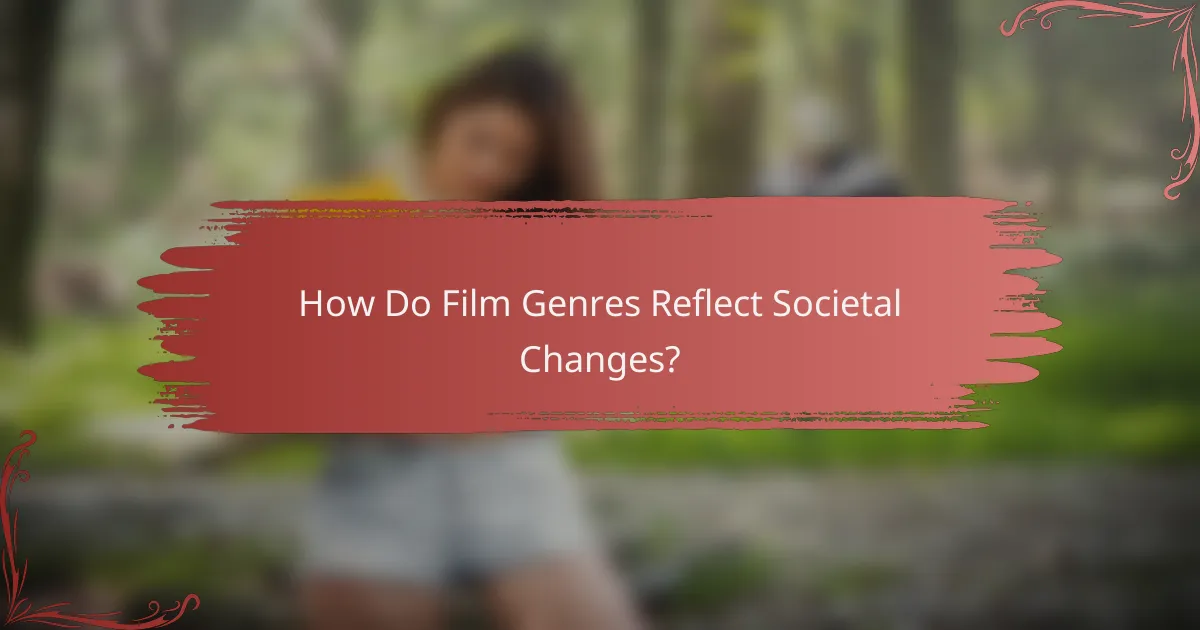Film genres are categories that classify films based on shared themes, styles, or narrative structures, playing a crucial role in shaping audience expectations and filmmaker strategies. This article explores the evolution of film genres, highlighting key milestones such as the transition from silent films to sound, the introduction of color, and the diversification of genres with the rise of independent films and streaming services. It examines how genres reflect societal changes, cultural values, and historical events, providing insights into audience preferences and industry trends. The discussion includes notable examples, such as the emergence of horror and feminist films, and how these genres address contemporary issues and anxieties.

What are Film Genres and Why Do They Matter?
Film genres are categories that classify films based on shared themes, styles, or narrative structures. They help audiences identify what to expect from a film. Genres like action, drama, and comedy provide a framework for storytelling. This classification aids filmmakers in targeting specific audiences. Understanding genres enhances the viewing experience by setting expectations. The recognition of genres dates back to the early days of cinema. For example, the Western genre became popular in the 1920s. Genres also influence marketing strategies and distribution channels. By categorizing films, industry professionals can better analyze trends and audience preferences.
How have film genres evolved over time?
Film genres have evolved significantly over time. Early cinema primarily featured silent films, often categorized into drama, comedy, and adventure. The introduction of sound in the late 1920s led to the rise of musicals and talkies, expanding genre classifications. The 1930s and 1940s saw the emergence of film noir, characterized by its dark themes and moral ambiguity.
In the 1950s and 1960s, genres diversified further with the popularity of science fiction and horror films, reflecting societal anxieties. The 1970s introduced the blockbuster era, with action and adventure genres dominating the box office. The 1980s and 1990s brought about the rise of romantic comedies and teen films, appealing to younger audiences.
In the 21st century, genres have continued to blend and evolve, with cross-genre films becoming common. Streaming platforms have also influenced genre development, allowing for niche genres to flourish. Overall, film genres have transformed in response to technological advancements and cultural shifts throughout history.
What historical events influenced the development of film genres?
The development of film genres has been significantly influenced by historical events. The emergence of silent films in the early 1900s coincided with World War I, leading to the rise of action and war genres. The Great Depression in the 1930s resulted in the popularity of musicals and comedies, providing escapism for audiences. The post-World War II era saw the rise of film noir, reflecting societal anxieties and moral ambiguity. The civil rights movement in the 1960s influenced the emergence of social issue films, addressing race and equality. The advent of technology, such as CGI in the 1990s, expanded the scope of science fiction and fantasy genres. Each of these historical events shaped audience expectations and the thematic focus of films, leading to the diverse genres we see today.
How do cultural shifts impact the emergence of new genres?
Cultural shifts significantly influence the emergence of new film genres. These shifts reflect changes in societal values, technologies, and collective experiences. For instance, the rise of feminism in the 1970s led to the emergence of the women’s film genre. This genre focused on women’s perspectives and issues, showcasing stories that resonated with changing gender dynamics. Similarly, the technological advancements in the 1990s, such as CGI, gave rise to the science fiction genre’s evolution. This allowed filmmakers to explore complex narratives and visual storytelling. Historical events also play a role; post-World War II, film noir emerged as a response to societal disillusionment. These examples illustrate how cultural contexts shape genre development.
What are the primary characteristics of different film genres?
Film genres are categories that define the style, themes, and narrative techniques of movies. Each genre has unique characteristics that distinguish it from others. For instance, action films emphasize physical feats and excitement, often featuring high-stakes situations. Comedies focus on humor and often include exaggerated characters and situations. Dramas explore emotional narratives and character development, frequently addressing serious themes. Horror films aim to evoke fear through suspenseful storytelling and often include supernatural elements. Science fiction explores futuristic concepts and advanced technology, often set in space or alternate realities. Documentaries present factual information about real events or people, utilizing interviews and archival footage. Animation features artistic visuals and can span various genres, appealing to both children and adults. Each genre’s characteristics shape audience expectations and influence filmmaking techniques.
What are the defining traits of major genres like drama, comedy, and horror?
Drama is characterized by serious narratives that explore emotional themes and complex characters. It often focuses on personal struggles and moral dilemmas. Key elements include character development, conflict, and a strong emotional arc. Examples of drama include films like “The Shawshank Redemption” and “Forrest Gump.”
Comedy is defined by humor and entertainment, aiming to provoke laughter. It often features exaggerated situations, misunderstandings, and witty dialogue. Common traits include lighthearted themes, comedic timing, and often a happy resolution. Notable examples include “Superbad” and “Groundhog Day.”
Horror is marked by its intention to evoke fear and suspense. It often includes supernatural elements, psychological tension, and graphic imagery. Key traits involve a dark atmosphere, shocking twists, and the exploration of primal fears. Prominent examples include “The Shining” and “Get Out.”
How do sub-genres differentiate from their parent genres?
Sub-genres differentiate from their parent genres by incorporating specific themes, styles, or narrative techniques. These characteristics create a distinct identity within the broader genre framework. For instance, horror films can be categorized into sub-genres like psychological horror or slasher. Each sub-genre emphasizes unique elements; psychological horror focuses on mental fear, while slasher films center on graphic violence. This differentiation allows for targeted audience engagement and niche storytelling. Historical examples include film noir, a sub-genre of crime films, which emphasizes moral ambiguity and visual style. Thus, sub-genres provide a more refined classification, enabling filmmakers to explore specialized narratives within their parent genres.

What are the Key Milestones in the Evolution of Film Genres?
The key milestones in the evolution of film genres include the establishment of silent films, the introduction of sound, and the rise of color films. Silent films, prevalent in the early 20th century, relied on visual storytelling. The Jazz Singer, released in 1927, marked the transition to sound. This innovation created the musical genre. The 1939 release of The Wizard of Oz showcased the use of Technicolor, influencing fantasy films. The 1960s saw the emergence of new genres like the spaghetti western, with films such as A Fistful of Dollars. The rise of independent films in the 1990s diversified genres further. Streaming services in the 21st century revolutionized access to various genres, allowing niche markets to thrive. Each milestone significantly shaped the landscape of film genres.
What significant films marked the birth of various genres?
The significant films that marked the birth of various genres include “The Birth of a Nation,” which established the epic genre in 1915. “The Cabinet of Dr. Caligari” is recognized as the first horror film, released in 1920. “The Jazz Singer,” released in 1927, is credited as the first significant sound film, marking the beginning of the musical genre. “Gone with the Wind,” released in 1939, defined the historical romance genre. “Citizen Kane,” released in 1941, is often hailed as the beginning of modern drama. Each of these films played a pivotal role in shaping their respective genres, influencing countless works that followed.
How did early cinema shape the foundations of film genres?
Early cinema significantly influenced the development of film genres by establishing narrative structures and visual styles. The silent film era introduced foundational genres such as comedy, drama, and horror. For instance, films like “The Great Train Robbery” (1903) showcased early action and adventure elements. These films utilized basic storytelling techniques that became genre conventions. Additionally, the introduction of specific themes and character archetypes helped solidify genre identities. The emergence of directors like D.W. Griffith further refined narrative techniques, influencing future storytelling in cinema. Overall, early cinema laid the groundwork for the diverse genres we recognize today.
What role did technological advancements play in genre development?
Technological advancements significantly influenced genre development in film. Innovations such as sound, color, and digital effects transformed storytelling methods. The introduction of synchronized sound in the late 1920s led to the musical genre’s rise. Color films, beginning in the 1930s, enhanced visual storytelling and expanded genres like fantasy and romance. The digital revolution in the 1990s allowed for advanced CGI, creating new possibilities for sci-fi and action genres. Additionally, streaming technology has diversified genres by enabling niche markets to thrive. Each advancement reshaped audience expectations and genre conventions, driving continuous evolution in film.
Which directors and filmmakers have influenced genre evolution?
Alfred Hitchcock significantly influenced the thriller genre. His techniques in suspense and psychological tension set new standards. Films like “Psycho” revolutionized horror elements within thrillers. Quentin Tarantino transformed the action and crime genres with non-linear storytelling. His film “Pulp Fiction” showcased unique character development and dialogue. Orson Welles’ “Citizen Kane” redefined narrative structure and cinematography in drama. His innovative use of deep focus and flashbacks influenced future filmmakers. Martin Scorsese’s work in crime drama, particularly “Goodfellas,” advanced character-driven storytelling. His authentic portrayal of mob life reshaped the genre. These directors have left lasting impacts on their respective genres, shaping the evolution of film.
What are some iconic films that redefined their respective genres?
Psycho redefined the horror genre with its shocking narrative twists and innovative editing techniques. Released in 1960, Alfred Hitchcock’s film introduced psychological depth to horror. The shower scene became a pivotal moment in cinematic history, influencing countless films. The Godfather transformed the crime genre with its complex characters and moral ambiguity. Released in 1972, Francis Ford Coppola’s film showcased the inner workings of organized crime. Its storytelling set a new standard for character-driven narratives. Star Wars revolutionized the science fiction genre by blending epic storytelling with groundbreaking special effects. Released in 1977, George Lucas’s film created a cultural phenomenon and established a new era in blockbuster filmmaking. Each of these films not only defined their genres but also influenced future filmmakers and shaped cinematic conventions.
How have filmmakers used genre blending to create innovative narratives?
Filmmakers have used genre blending to create innovative narratives by combining elements from different genres. This technique allows for unique storytelling opportunities and engages diverse audiences. For example, the film “Get Out” blends horror and satire to address social issues. Similarly, “The Shape of Water” merges fantasy and romance, creating a distinctive narrative experience. Genre blending can challenge traditional storytelling conventions and offer fresh perspectives. By mixing genres, filmmakers can explore complex themes and character development. This approach has led to critically acclaimed works and box office successes, demonstrating its effectiveness in modern cinema.

How Do Film Genres Reflect Societal Changes?
Film genres reflect societal changes by mirroring cultural values, social norms, and historical events. For instance, the rise of horror films in the 1970s coincided with societal fears surrounding political instability and economic crises. Similarly, the emergence of feminist films in the 1990s highlighted the growing awareness of gender equality issues. Genres like science fiction often explore technological advancements and their implications on society, reflecting contemporary anxieties about the future. Documentaries have gained popularity as they address pressing social issues, such as climate change and social justice movements. Historical dramas often depict significant events, influencing public perception and understanding of history. Overall, film genres serve as a lens through which societal changes can be examined and understood.
What themes are commonly explored within various film genres?
Common themes explored within various film genres include love, conflict, and morality. Romantic films often focus on love and relationships. Action films typically emphasize conflict and heroism. Horror films explore fear and survival. Science fiction often examines humanity and technology. Drama delves into personal struggles and moral dilemmas. Each genre utilizes these themes to engage and resonate with audiences. These themes enhance storytelling by providing relatable experiences.
How do genres address contemporary social issues?
Genres address contemporary social issues by reflecting societal concerns through narrative and character development. They provide a platform for exploring themes such as inequality, identity, and justice. For example, dramas often depict personal struggles against systemic oppression. Documentaries highlight real-world issues, offering factual insights and raising awareness. Comedies can use satire to critique social norms and provoke thought. Horror films may address fears related to societal anxieties, such as technology or environmental disasters. Research shows that films can influence public perception by framing social issues in relatable contexts. Studies indicate that audiences engage with these themes, leading to discussions and potential social change.
What role does audience reception play in the popularity of genres?
Audience reception significantly influences the popularity of film genres. When audiences connect positively with a genre, it gains traction and visibility. Positive reception can lead to increased box office success and critical acclaim. Genres that resonate with viewers often inspire similar future productions. For example, the success of horror films in the 1970s led to a surge in similar releases. Conversely, genres that receive negative feedback may decline in popularity. Historical data shows that audience preferences shape industry trends over time. This dynamic relationship between audience reception and genre popularity is crucial for understanding film evolution.
What are the current trends in film genres today?
Current trends in film genres today include a rise in hybrid genres and an emphasis on diversity. Hybrid genres combine elements from multiple categories, creating unique viewing experiences. For instance, action-comedy films have gained popularity, blending humor with thrilling sequences. Additionally, there is a growing focus on diverse storytelling. Films featuring underrepresented voices are increasingly prominent in mainstream cinema. Data from the 2022 Sundance Film Festival shows a 30% increase in films directed by people of color. Streaming platforms also contribute to this trend by providing a wider array of genre-bending content. Overall, the film industry is evolving to reflect a broader range of narratives and styles.
How have streaming platforms influenced genre popularity?
Streaming platforms have significantly influenced genre popularity by providing diverse content to global audiences. They enable niche genres to reach wider audiences that traditional media often overlooks. For example, platforms like Netflix and Hulu have invested in original content across various genres, including horror and documentaries. This investment has led to increased viewership and popularity for these genres. Data shows that horror films have seen a resurgence, with streaming platforms accounting for a substantial portion of their viewership. Moreover, algorithms on these platforms promote content based on user preferences, further shaping genre trends. This targeted approach helps lesser-known genres gain traction and visibility. Overall, streaming platforms have democratized access to a variety of film genres, altering their popularity dynamics.
What emerging genres are gaining traction in modern cinema?
Horror-comedy and elevated horror are emerging genres gaining traction in modern cinema. Horror-comedy blends humor with traditional horror elements, appealing to diverse audiences. Elevated horror focuses on psychological themes and character development, offering deeper narratives. The success of films like “Get Out” showcases the popularity of elevated horror. Similarly, “What We Do in the Shadows” exemplifies the appeal of horror-comedy. Streaming platforms are also fueling genre experimentation, promoting innovative storytelling. These trends reflect audience desires for fresh perspectives in cinematic experiences.
What are some practical tips for analyzing film genres?
To analyze film genres effectively, start by identifying genre conventions. These conventions include recurring themes, character types, and visual styles. Next, examine the narrative structure typical of the genre. For example, horror films often follow a specific plot progression. Analyze the use of cinematography and sound, as these elements can influence genre perception. Consider the cultural context in which the film was made. Historical and social factors can shape genre characteristics. Lastly, compare the film to other works within the same genre. This comparison can highlight unique and common attributes. These tips provide a structured approach to understanding film genres.
The main entity of the article is film genres, which are categories that classify films based on shared themes, styles, or narrative structures. The article provides a comprehensive overview of the evolution of film genres, highlighting their historical significance, key milestones, and the influence of societal changes and technological advancements. It discusses the characteristics of major genres such as drama, comedy, and horror, as well as the emergence of sub-genres and the role of directors in shaping genre development. Additionally, the article examines current trends in film genres, including the impact of streaming platforms and the rise of hybrid genres.
